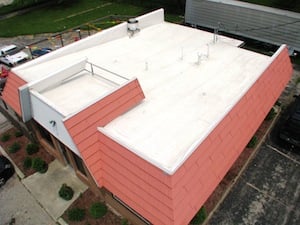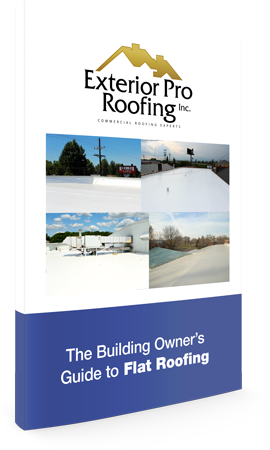 Steep-slope roofing is classified as applying a water-shedding roof covering to a surface with a slope of more than 14 degrees. This covering does not need to be watertight as water will run right off, but it will likely be visible from the ground and thus need to compliment the aesthetics of the building.
Steep-slope roofing is classified as applying a water-shedding roof covering to a surface with a slope of more than 14 degrees. This covering does not need to be watertight as water will run right off, but it will likely be visible from the ground and thus need to compliment the aesthetics of the building.
Below we’ll walk you through six generic classifications of steep-slope roof materials to help as you discuss your options with your contractor.
But before we get into the roof coverings, we need to discuss the underlayment.
Underlayment Sheets
Steep-slope roofing need to use an underlayment, which is fabric material applied to the roof’s surface prior to installation of the primary covering. This material provides additional protection to the roof, but is not directly exposed to the elements.
They are generally comprised of organic felts, glass fiber mats, composites or modified bitumen sheets. They are also either mechanically fastened (most common) or self-adhered (common when used for ice dam protection) to the roof.
Underlayment sheets must adhere to the following ASTM standards:
- ASTM D 226, “Standard specification for asphalt saturated organic felt used in roofing and waterproofing.”
- ASTM D 1970, “Standard specification for self-adhering polymer modified bitumen sheet materials used as steep roofing underlayment for ice dam protection.”
- ASTM D 4869, “Standard specification as asphalt saturated organic felt shingle underlayment used in roofing.”
6 Steep-Slope Roof Coverings
1. Asphalt Shingles
Asphalt shingles are made up of several layers:
- A base material, either organic felt or a glass fiber mat. This base supports weather resistance and strength.
- Asphalt and assorted fillers.
- A surface material (generally mineral granules), which provides protection from impact and UV degradation, and improves fire resistance.
The most common type of shingle is a strip shingle, which is 12-in. x 36-in., and includes three or four exposed tabs. These tabs can be separated from each other, one continuous piece (called non-cutout strip shingles), or randomly distributed (called random tab strip shingles).
These shingles can also come in a single layer, or with two or more layers. The latter are called laminated strip singles or architectural shingles.
Asphalt shingles must meet the following ASTM standards:
- ASTM D 225, “Standard specification for asphalt shingles (organic felt) surfaced with mineral granules.”
- ASTM D 3462, “Standard specifications for asphalt shingles made from glass fiber felt and surfaced with mineral granules.”
2. Clay and Concrete Tile:
There are two main types of roofing tiles: Clay and Concrete.
- Clay Tiles: Produced by baking molded clay. The density of the tile is determined by the length of time and temperature the clay is heated.
- Concrete Tiles: Made of portland cement, sand and water, concrete tiles are mixed and extruded under high pressure into molds.
Tiles are available in a variety of profiles, styles, finishes and colors, and textures can be applied.
Clay tiles must meet the following ASTM standards:
- ASTM C 1167, “Standard specification for clay roof tiles.”
3. Fiber-Cement Shingles:
As the name would imply, fiber-cement shingles are made of cement and reinforced fibers. They are designed to serve as substitutes for wood shingles and shakes, slate, and tile in steep-slope applications.
They are made to look like and simulate these materials, and in most cases are installed in a similar fashion. However, they may not perform as well.
Fiber-cement coverings must meet the following ASTM standards:
- ASTM C 1225, “Specification for non-asbestos fiber-cement roofing shingles, shakes and slates.”
4. Metal Coverings and Components:
There are two general types of metal roof systems: architectural and structural. Architectural metal possess water-shedding qualities, making it ideal for steep-slope roofing systems. See flat-roof materials for more information on structural metal.
Architectural metal can be categorized into the following:
- Individual components: Metal-roofing products designed to resemble traditional steep-slope residential products.
- Panels: Large sheets that include several different categories:
- Standard seam: The seams are joined above the panel flats.
- Batten seam: Vertical leg panels placed between wooden batten strips and covered with a cap.
- Flat seam: Individual panels applied in a shingled application.
- Bermuda panel: A continuous panel positioned perpendicular to the roof slope, creating horizontal lines.
- Shingle panel: Die-formed panels designed to look like tile, slate or wood shingles.
Solid roof sheathing or decking is required for this roofing system.
5. Slate:
Slate is a dense, durable, naturally occurring material that is essentially nonabsorbent.
The surface texture of slate is determined by the rock from which it was quarried. Some will appear smooth, while others are rough and uneven. The color and the degree to which the color changes after exposure to weather will also vary based on the rock used.
There are three classifications of slate:
- Standard: Usually between 3/16-in. and 1/4-in. thick, rough surface and uniform length.
- Standard Smooth: A standard slate but with a smooth surface.
- Graduated/textural: Designed in varying lengths, thicknesses and are rougher than standard slate.
Slate must meet the following ASTM standards:
- ASTM C 406, “Standard specification for roofing slates.”
6. Wood Shakes and Shingles:
Made of Western red cedar, cypress, pine and redwood trees, wood steep-slope roofing materials are available in shakes and shingles.
- Shingles are sawed on both sides, have an even taper and uniform thickness. They generally come in two sizes: Perfection (18-in.) and royal (24-in.).
- Shakes are split from logs and reshaped by manufacturers for commercial use. They tend to be thicker at the butt end than shingles, and one or both sides are split to give it a texture.
It’ll be important to consult with your roofing contractor on the best steep-slope roofing system for your building and the environment it will be exposed to. For example, level of protection, weather resistance and aesthetics all need to be taken into account.
Everything Building Owners Need to Know When Selecting a Roof
It's all in this free ebook, The Building Owner's Guide to Roofing. In it, you'll learn how to select the best contractor, roofing membrane and warranty for your needs. Download it today.







